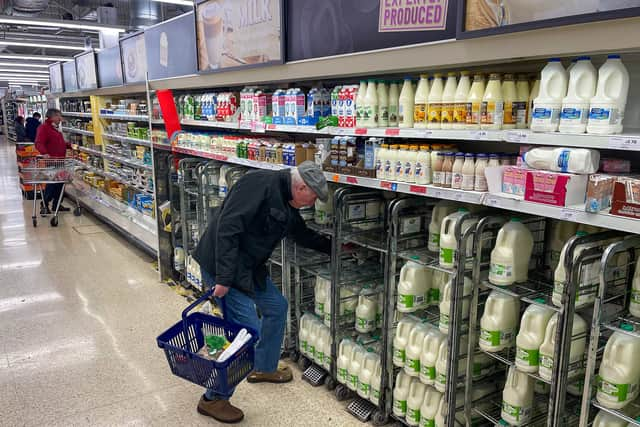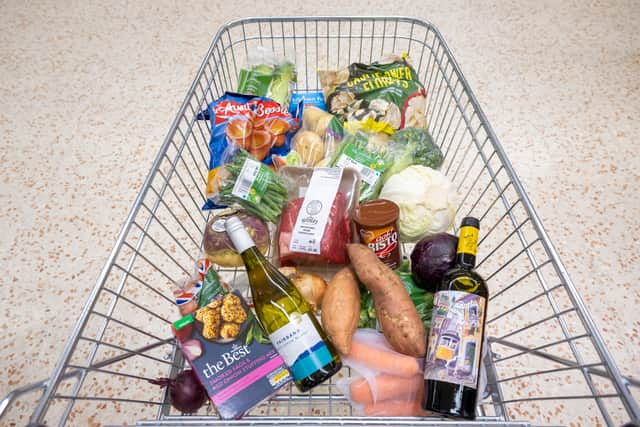Cost of living: Inflation plummets to 8.7% but food prices remain ‘worryingly high’ - how it affects you
and live on Freeview channel 276
UK inflation made a sharp drop to 8.7 per cent in the 12 months to April, with the measure of price finally slipping out of double digit territory - but food costs remain “worryingly high” as the cost of living crisis continues. According to the latest data from the Office for National Statistics (ONS), the figure is down from the 10.1 per cent recorded in March.
It’s the first time inflation has dropped below double digits since August last year. But there are still concerns over the rate at which food prices are rising, with Chancellor of the Exchequer Jeremy Hunt stating today (May 24) they remain “worryingly high”.
Advertisement
Hide AdAdvertisement
Hide AdMr Hunt told BBC News that the new inflation figure was a step in the right direction “but there are things underneath those numbers, which show that this battle is far from over.” He added: “We have never celebrated anything. Until we achieve our objective to halve inflation, the job is not done.”
The decline in inflation is being driven by gas and electricity costs remaining stable in April, according to the ONS. It should also be noted that even though inflation is going down, prices are still going up - just at a marginally slower rate.
The ONS found that food and non-alcoholic beverage prices continued to rise throughout April and contributed to the higher inflation rate. This dropped slightly from 19.2per cent in the year to March to 19.1 per cent in the year to April - still a high figure.
Here’s everything you need to know including why inflation is so high and if prices will start to fall again soon.
Advertisement
Hide AdAdvertisement
Hide AdWhat is inflation - and why is it so high?
The Consumer Price Index (CPI) measure of inflation tracks how prices have changed over a year. When inflation is higher, you’re paying more for something compared to one year ago.
If something cost £1 last year and the rate of inflation is 2 per cent, for example, it would cost £1.02 today. With the 10 per cent inflation figure, if something cost £1 a year ago - it would cost £1.10 now. It also means you’re not getting as much for your money as you used to.


This is especially bad when inflation outstrips wage growth, as you need to use a higher percentage of your money to buy everyday essentials.
What the current inflation rate means for you
Prices are still going up, just not as fast
Prices are still rising fast compared to a year ago - just at a slower rate than they have been. Prices are also still likely to keep increasing over the next few months, but not at the shocking rate we’ve seen over the last year.
Your costs might be rising even faster - or more slowly
Advertisement
Hide AdAdvertisement
Hide AdThe ONS bases its figures on a basket of goods that reflects what the average person in the UK is buying. So if you are buying a lot of unusual or niche items, you might find the cost of your own bag of shopping is going up more quickly - or more slowly.


Inflation expected to keep falling
Inflation peaked at a 41-year high of 11.1 per cent in October last year, but is expected to keep going down in 2023. In March the Bank of England governor Andrew Bailey said inflation was predicted to “fall sharply” from the early summer throughout the rest of 2023.
It’s worth noting that this is not a gurantee, as many factors affect the level of inflation including the cost of energy and food which have been the key driving factors of inflation over the last year. Economists at the Office for Budget Responsibility (OBR) have previously predicted that inflation will fall back to 2.9 percent by the end of 2023.
Why falling prices isn’t always a good thing
Falling prices aren’t always a good thing, as if people expect that prices are likely to fall, they delay spending with the aim of getting a cheaper deal later on. It means businesses have less money coming in, so they try to find ways to cut costs, sometimes by laying off staff or slashing wages.
So prices falling can mean people lose their jobs, which in turn makes prices fall further. This kind of economic crisis is called “deflation” and comes with problems of its own.
